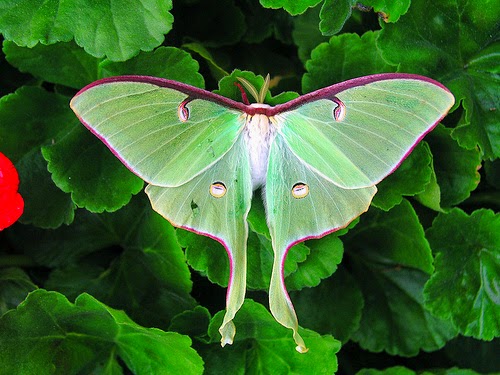The world is a place full of natural wonders, many of which I will never see firsthand. I’m fine with that. There is so much to see on a daily basis here on the marsh. Flora, fauna…Gaia’s handiwork. Sublime.
The other evening (this past Friday) I was sitting on the sofa after a busy day at work. Glenn was coming in after having a smoke on the front porch. He told me there was a big green moth on one of the solar walkway lights we have at the head of our front walk. It piqued my interest. He said “big”, but I didn’t think it would really be all that big. One person’s big is another person’s average. (okay, people…*snerk*) Before I went in search of my camera, I decided to investigate things first. Wanted to see just how “big” this moth was.
We are entering the final weeks of Summer here in the sticky and humid south. As with most places in the northern hemisphere sharing this hot season, the days are longer. No flashlight required until much later. Stepping out the front door, the air wasn’t as heavy as I expected, but it was still mid-evening. The overall energy outside was calm, and the light level was dimming by the minute. The solar walkway lights weren’t shining (they hardly shine at the best of times), but there was plenty of natural light to see by. Looking down to the left light there was the moth. Big and green it was. I’ll add beautiful to that description, too.
Crossing my fingers, I dashed inside to look for the camera. I’m so used to trying to catch photos of the other butterflies that flit around here. They aren’t very good at sitting still. Having to take a moment to get just the right focus to justify the beauty of them usually kills the photo op. After locating said camera I headed back out the door…
…and was relieved to see that it was still there. It hadn’t appeared to have moved a muscle. As the light fixture is quite low to the ground I had to get down to its level. Still it didn’t move. On closer inspection I saw that it was perched on what looked to be some abandoned spider web remnants. My first thought was “is it dead”, but after gently touching it with a dried pine needle I noticed it move a little. I proceeded to snap away.
As you can see from the above photo, this beauty was looking a bit tattered in the hindwing area. Otherwise, it was in beautiful shape. This is by far the biggest moth I have seen up close. Over the years I have marveled at the size and color of the bigger varieties of moths I have seen online in pictures. Royals, Emporers…even the Atlas moth which is bigger than many birds. Quite impressive. I decided my model had had enough, so I left it to its business and headed in to upload my pics and do some research.
 |
My moth’s wingspan was at least 4 to 5 inches. Its antennae were a bit ‘bushy’, so that means it was a male. Luna Moth mate after midnight, and the female lays her eggs the following evening. Fast, huh? The eggs are laid on the underside of leaves, and there are several host trees of choice (see picture below).
The mating and resulting egg laying is spaced every 8 to 10 weeks beginning in March. In the south there are as many as 3 per season. The female lays her eggs 100-300 at a time in groups of 4-7 eggs at a time. The eggs then incubate for 8-13 days. After the eggs hatch, the caterpillars go through 5 “instars” before cocooning. (“Instars” are developmental stages that lead to a certain level of sexual maturity before entering the cocoon.)
 |
| (Starting at the top: Moth eggs, Caterpillar, Cocoon, Pupal case) |
Sadly, these beautiful creatures don’t live long. They reach adulthood solely to mate. Saturniidae do not eat as they don’t really have mouths. They emerge from their cocoons to mate, and live only about one week.
The internet sources I consulted about these moths were divided on one aspect of the Luna Moth. How abundant they are. A few sources said that they are rare enough to be “endangered” in some areas. Other said that they are fairly common, but because of their short lives they aren’t seen by many people. Whatever the case may be I count myself lucky. If Glenn hadn’t looked down at our light he may have never noticed our green visitor. As tattered as he was, my viewing of a Luna Moth first hand was so special. After all, he is named for one of my favorite things…the Moon.
On my internet surfing on this subject I came across a site dedicated to tracking 'lepidoptera' sightings. (Lepidoptera include both moths and butterflies.) I decided to report my sighting, and now have a confirmed sighting post on their website. The following is a link to my entry on the site: http://www.butterfliesandmoths.org/sighting_details/996469 In retrospect I would have left more articulate sightng notes...I didn't realize they would be publishing what I initially sent...lol. It is worth it to check out their moth and butterfly images. You'll see some beauties.
On my internet surfing on this subject I came across a site dedicated to tracking 'lepidoptera' sightings. (Lepidoptera include both moths and butterflies.) I decided to report my sighting, and now have a confirmed sighting post on their website. The following is a link to my entry on the site: http://www.butterfliesandmoths.org/sighting_details/996469 In retrospect I would have left more articulate sightng notes...I didn't realize they would be publishing what I initially sent...lol. It is worth it to check out their moth and butterfly images. You'll see some beauties.







No comments:
Post a Comment